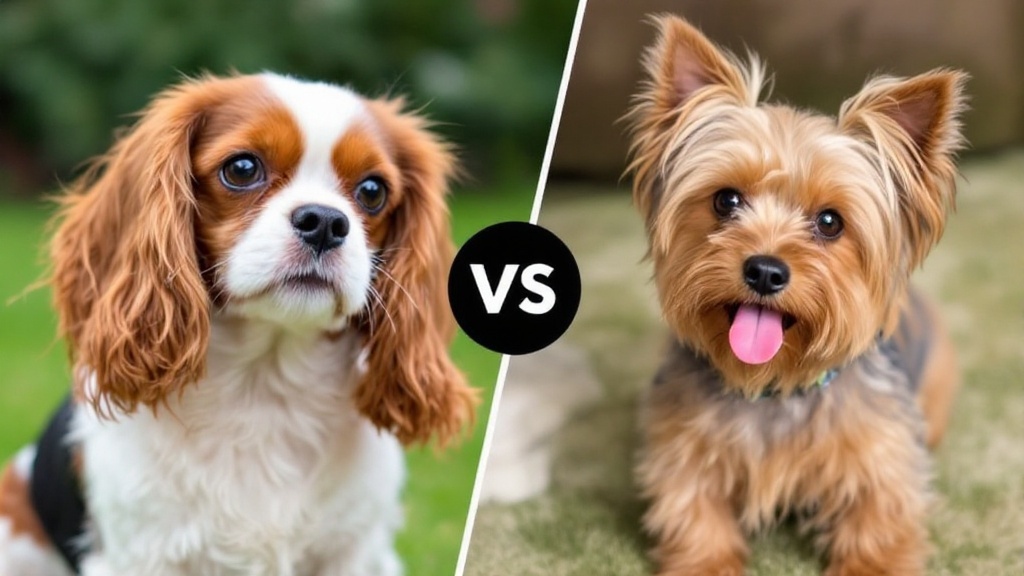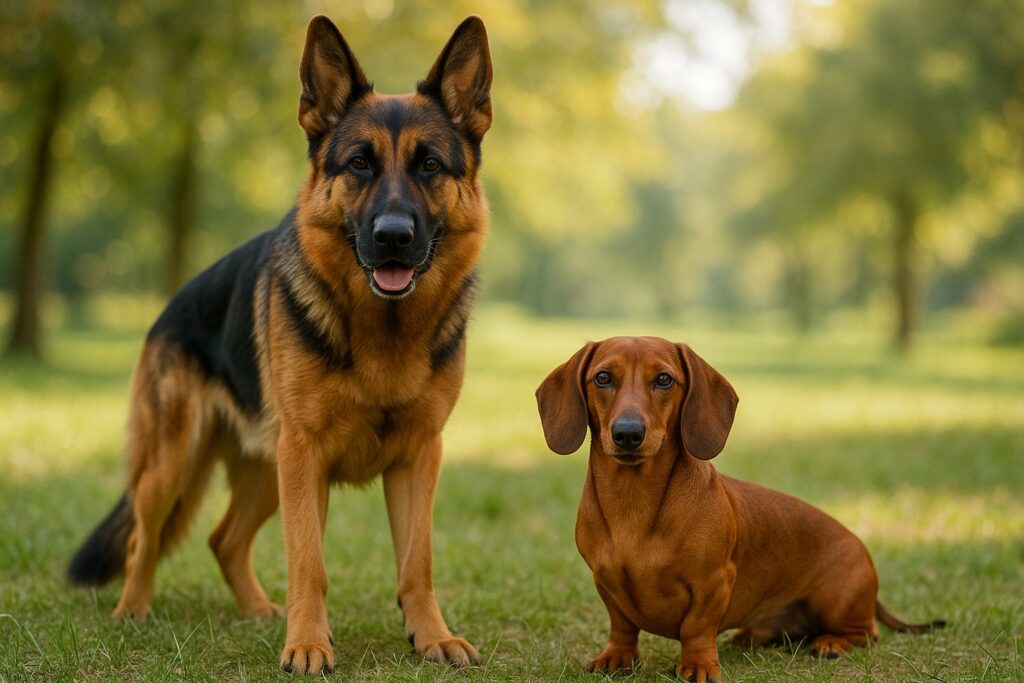If you’re choosing between the Cavalier King Charles Spaniel and the Yorkshire Terrier, it’s important to know which breed better fits your lifestyle. Both are popular small dog breeds, but they have their differences in personality, care needs, and looks.
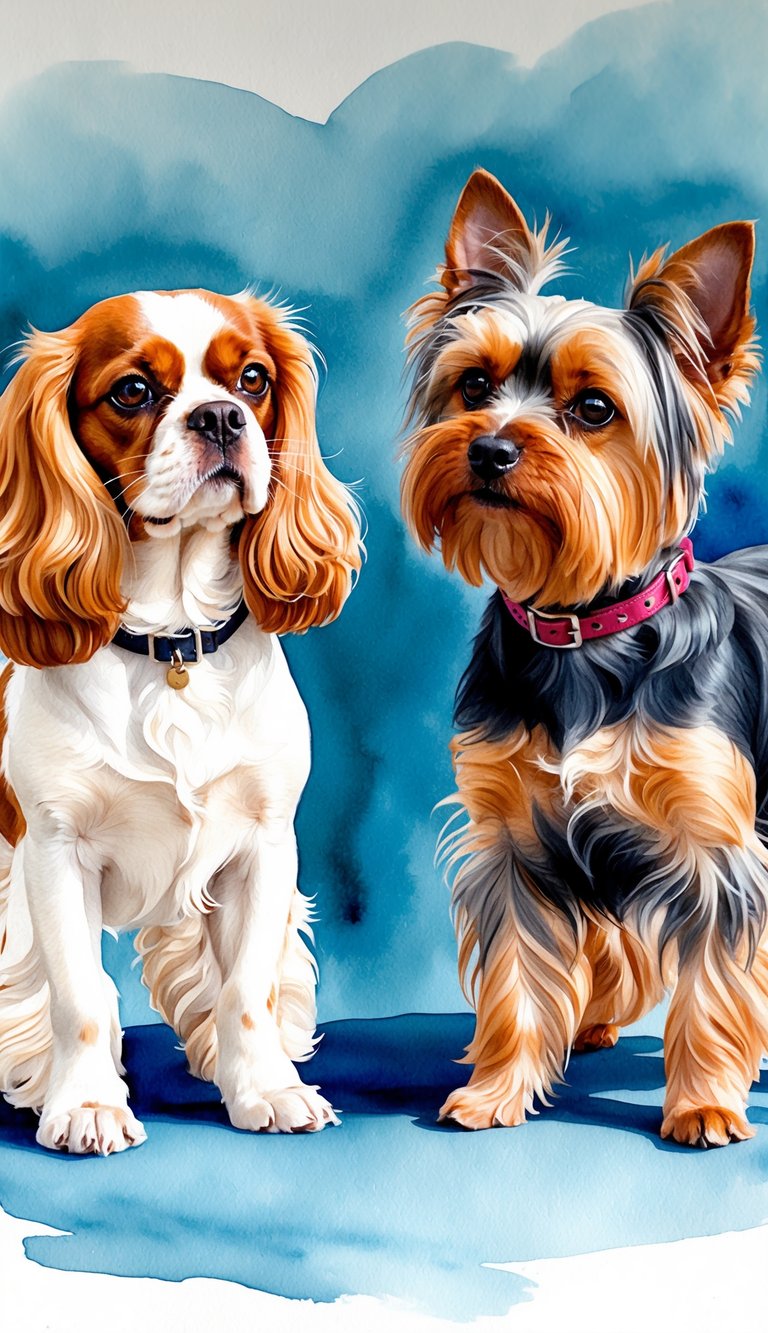
The Cavalier King Charles Spaniel is friendly and gentle. The Yorkshire Terrier, or Yorkie, is brave and full of energy.
Both breeds fall under the toy breeds category. They do well in smaller homes or apartments.
You’ll notice differences in grooming, exercise needs, and training styles with these two dog breeds. Learning these details can help you decide which pet is right for you and your family.
Origin and Breed History
Cavalier King Charles Spaniels were bred to be lap dogs for British royalty. Yorkshire Terriers come from working-class roots as rat hunters in England.
Both breeds now stand out as loved family pets, but their backgrounds and related breeds show important differences.
Cavalier King Charles Spaniel Background
The Cavalier King Charles Spaniel has close ties to British royalty, especially King Charles I and II. These small dogs were favorites in royal courts during the 16th and 17th centuries.
Their main purpose was to serve as companion animals, bringing comfort and warmth to their owners. Breeders focused on a gentle, affectionate nature, making them excellent family pets.
Cavalier King Charles Spaniels are part of the toy breed group. Their looks have changed over time, but their sweet personality has always been important to breeders.
You’ll find them often compared to Poodles and Shih Tzus for their loyal and loving traits.
Yorkshire Terrier Background
The Yorkshire Terrier began in northern England during the 1800s. These dogs were first bred to catch rats in mills and mines.
They come from a mix of terrier breeds, including the now-extinct Clydesdale Terrier. Yorkies are known for their fearless attitude, small size, and silky blue and tan coats.
Their status changed from working dogs to fashionable companion dogs as they became popular with city dwellers. Today, Yorkshire Terriers are a top choice for families who want a bold, friendly, and easy-to-train pet.
They are commonly seen alongside other small breeds, such as Miniature Schnauzers and Toy Poodles.
Comparison With Related Breeds
Both breeds belong to the toy group, designed for companionship and ease of care. Yet, their histories show clear differences.
Cavalier King Charles Spaniels have always been bred for gentle company. Yorkshire Terriers were selected for their energy and hunting skills before becoming lap dogs.
Other toy breeds have similar backgrounds. For example, Shih Tzus also started as royal companions in Asia, while Miniature Schnauzers and Poodles were bred for specific tasks before shifting to family life.
This range of histories affects not just appearance but also how each breed fits into a home or family.
Physical Characteristics
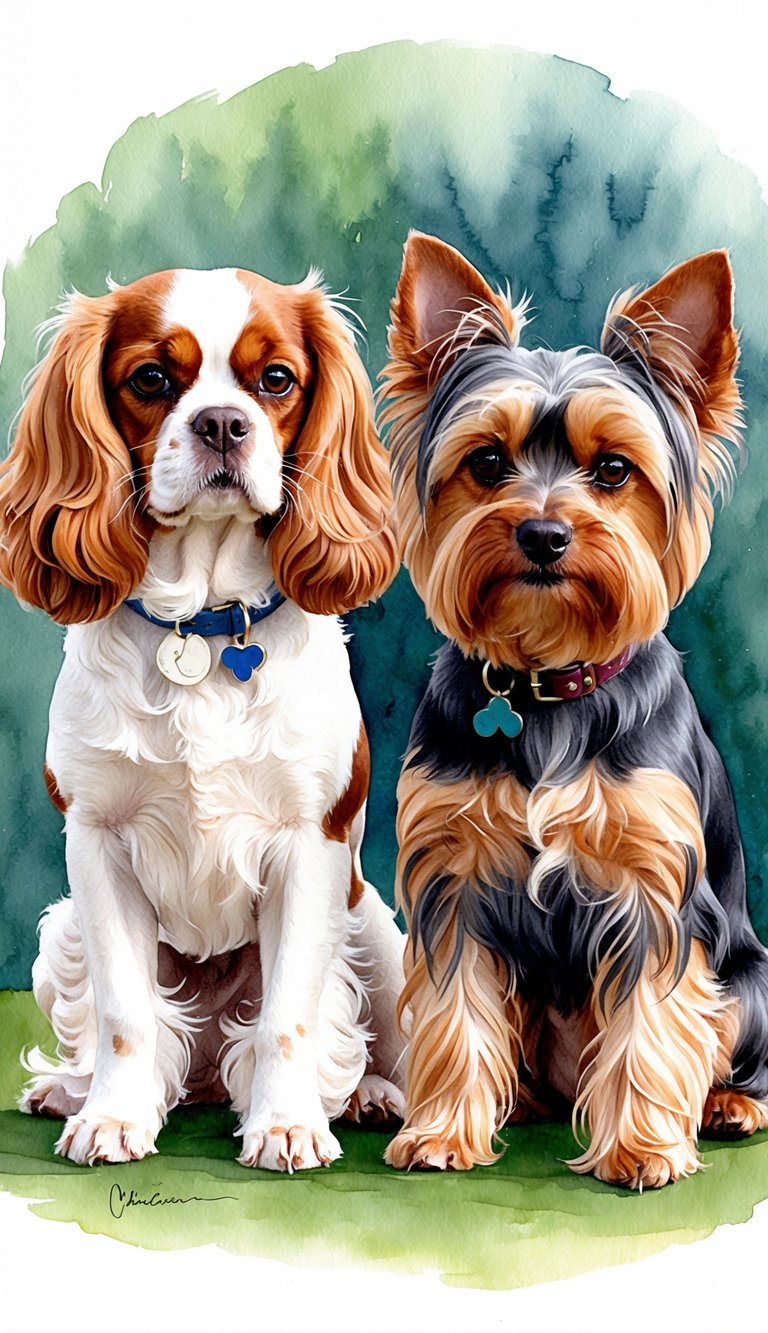
Cavalier King Charles Spaniels and Yorkshire Terriers both stand out, but have very different builds, coats, and facial features. Understanding their size, coat, and looks can help you tell them apart and make the right choice for your home.
Size and Weight Differences
The Cavalier King Charles Spaniel is a small but sturdy dog. Adults usually weigh between 13 to 18 pounds (6 to 8 kg) and stand about 12 to 13 inches (30 to 33 cm) tall at the shoulder.
This gives them a solid, slightly longer frame compared to other toy breeds, like the Pomeranian or Toy Poodle, which are even smaller. The Yorkshire Terrier is more petite.
Most weigh 4 to 7 pounds (1.8 to 3.2 kg) and stand 7 to 8 inches (18 to 20 cm) tall. Their lighter frame makes them easy to carry and suited for smaller living spaces.
Yorkshire Terriers are even smaller than Miniature Schnauzers, which typically weigh much more.
| Breed | Adult Weight | Adult Height |
|---|---|---|
| Cavalier King Charles Spaniel | 13-18 lbs | 12-13 inches |
| Yorkshire Terrier | 4-7 lbs | 7-8 inches |
| Pomeranian | 3-7 lbs | 6-7 inches |
| Toy Poodle | 4-6 lbs | 10 inches max |
| Miniature Schnauzer | 11-20 lbs | 12-14 inches |
| Beagle | 20-30 lbs | 13-15 inches |
Coat Types and Colors
The Cavalier has a medium-long, silky coat that is soft and smooth to the touch. Their fur can be wavy or straight and often features feathering on the ears, chest, legs, and tail.
Common coat colors are Blenheim (chestnut and white), tricolor (black, white, and tan), black and tan, and ruby (solid red). The Yorkshire Terrier, in contrast, has a straight, fine, and glossy coat that grows quite long if left untrimmed.
Yorkies are most famous for their blue and tan coloring, which may lighten or change slightly as they age. They shed very little, making their fur different than the Cavalier or Beagle, who both shed more.
The Pomeranian and Toy Poodle each have distinctive, thick, double coats or curly hair, which further separates them from the straight or silky look of Cavaliers or Yorkies.
Distinctive Features
Cavalier King Charles Spaniels are known for their large, round, dark eyes, giving them a gentle, expressive face. Their long, floppy ears are well-furred and swept back, framing their heads.
They have a slightly rounded skull and a softly tapering muzzle. Yorkshire Terriers feature a compact face with a black nose and small, V-shaped ears that usually stand upright.
Their short muzzle and bright, dark eyes give them an alert, spirited appearance. The long, parted hair on their head is also a signature look—many owners tie it up in a “topknot.”
Compared to breeds like the Beagle, who have a longer body, straight tail, and shorter coat, both Cavaliers and Yorkies look delicate and are smaller in size. Beagles are also more muscular and have larger, longer ears compared to the compact head and petite ear structure of Yorkies.
Temperament and Personality
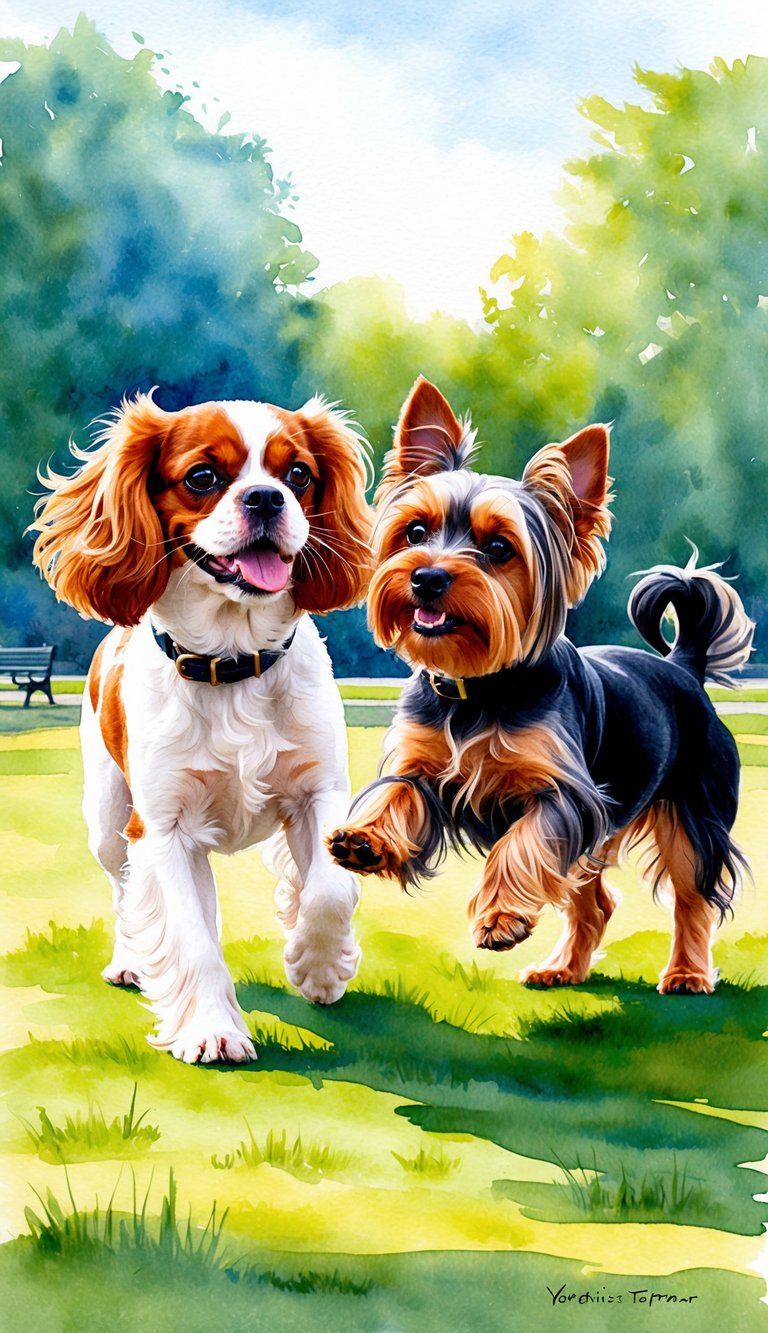
Cavalier King Charles Spaniels are known for their gentle, affectionate attitude. Yorkshire Terriers show a feisty and energetic spirit.
Your decision may depend on how outgoing or calm you want your pet to be, as well as compatibility with families or other dogs.
General Disposition
Cavalier King Charles Spaniels are friendly, easygoing dogs. They love being close to their owners and tend to follow you around the house.
These dogs rarely show aggression and usually get along well with strangers and other pets. Yorkshire Terriers are bold and lively.
They can be more territorial and may bark at new people or animals. Even though they are small, they act like watchdogs and want to protect their space.
This breed can be stubborn, but with steady training, they also show loyalty and affection. Both breeds bond strongly with their human families.
They enjoy attention and can get lonely if left alone for long periods. Cavaliers are generally more laid-back, while Yorkies are more alert and energetic.
Interaction With Families and Children
Cavalier King Charles Spaniels are patient with children. They enjoy playing and cuddling, making them great for families with kids.
They rarely nip or snap and are tolerant of gentle handling. Yorkshire Terriers can do well with children, but they need supervision.
Their small size makes them fragile, and rough play can scare or injure them. Some Yorkies may act bossy around young children or other small pets, so early socialization is important.
If your family has kids who are gentle and understand dog boundaries, either breed can work. Cavaliers tend to fit better into homes with children of all ages.
Yorkies may be better for families with older children who know how to treat small dogs carefully.
Suitability for Companion and Family Life
Cavalier King Charles Spaniels are classic companion dogs. They adapt easily to different living situations, including apartments.
Cavaliers enjoy cuddling on the couch but are also happy to go out for walks. They are often suggested for first-time dog owners and for people seeking loyal, loving pets.
Yorkshire Terriers can also be good family pets, especially in smaller homes or apartments. They are playful and alert, offering companionship and entertainment.
Yorkies are good for owners who are active but still want a lapdog. Early training and socialization help ensure their confidence does not turn into stubbornness or bossiness.
Compared with breeds like the Bichon Frise and Havanese, both Cavaliers and Yorkies are loving and social, but Cavaliers are generally calmer. If you want a relaxed companion, a Cavalier is a good choice.
If you prefer a small dog with a bit more energy and attitude, a Yorkie may be a better fit.
Exercise and Activity Needs
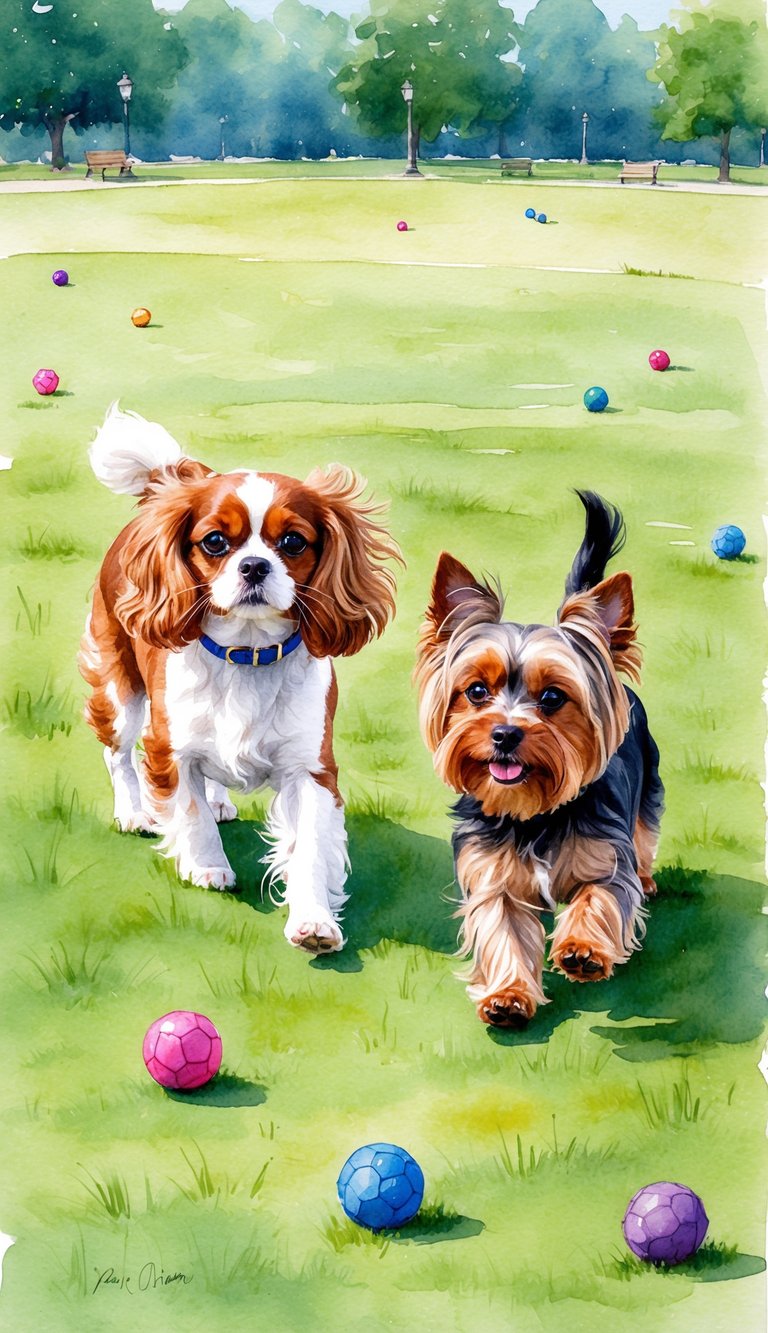
Both the Cavalier King Charles Spaniel and the Yorkshire Terrier are active and alert. They have unique energy levels and ways of staying entertained.
Their exercise needs are not as high as some working breeds like the Border Collie, but daily activity is still important to keep them healthy.
Playfulness and Energy Levels
Yorkshire Terriers often have bursts of energy and may act playful for much of the day. They love chasing toys and exploring new spots.
Sometimes they act stubborn, too. Although small, Yorkies have more spirit than you might expect.
Cavalier King Charles Spaniels are gentle and active, enjoying play but not quite as intense or spunky as a Jack Russell Terrier. Cavaliers love playing fetch but are usually calmer indoors.
They tend to match your mood and can enjoy quiet times as much as playful moments. Neither breed needs as much exercise as a Beagle or a Border Collie, but both appreciate daily play and attention.
If you like a playful dog but prefer moderate energy, the Cavalier is a good fit. If you want a small dog with a bold personality, the Yorkshire Terrier is a strong choice.
Outdoor and Indoor Activities
Yorkshire Terriers enjoy short walks, trips to the park, and agility games. Because they are small, too much rough activity can tire them out.
They are also good at playing indoors with simple toys and love learning tricks. Cavalier King Charles Spaniels also benefit from daily walks and outside time.
They like to sniff and explore, sometimes acting curious like a Dachshund. Gentle games of fetch or hide-and-seek can be done outside or in a hallway.
Tips for daily activities:
- Short walks (20–30 minutes)
- Interactive toys
- Supervised playtime with children
- Training games
Neither breed needs harsh or exhausting exercise. They do best with routines that mix gentle walks and play with rest.
This will help prevent boredom and promote good behavior.
Grooming and Maintenance
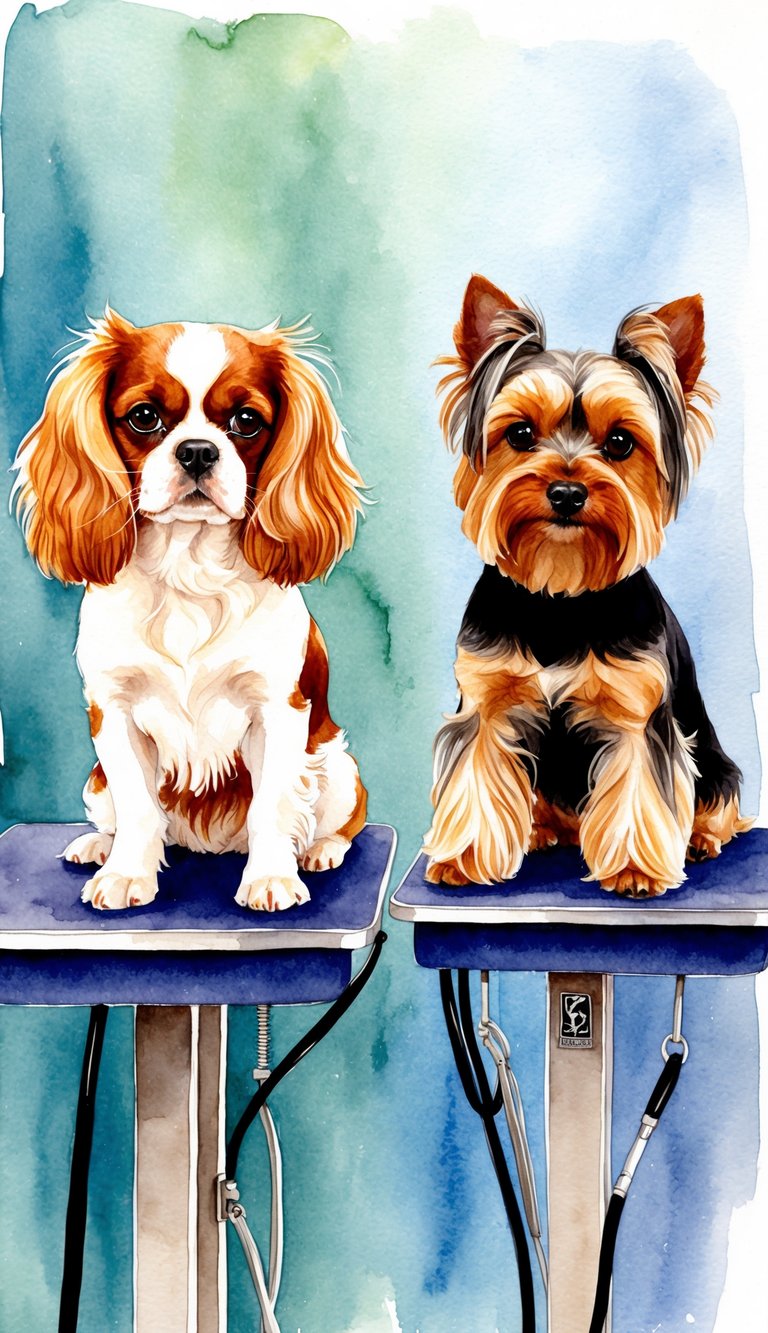
Both Cavalier King Charles Spaniels and Yorkshire Terriers need regular grooming. Their coat types and care routines are different.
How much you need to groom, and how much hair you may find in your home, depends on which breed you choose.
Coat Care Requirements
The Cavalier King Charles Spaniel sports a smooth, silky coat that reaches medium length. You’ll want to brush their coat at least three or four times a week to keep tangles and mats at bay, especially near their ears and legs.
A little trimming around their feet and sanitary spots keeps them looking tidy. It’s not a huge job, but it does help.
Yorkshire Terriers have long, straight, fine hair. Their hair grows like ours and can hit the floor if you don’t trim it.
Daily brushing is a must for long-haired Yorkies to prevent knots and tangles. If you go for a “puppy cut,” brushing every other day usually does the trick.
Breeds such as the Shih Tzu, Maltese, Poodle, and Bichon Frise also need frequent grooming because of their long or curly coats. Most of the time, these breeds benefit from professional grooming every month or two.
Short trims on any of these breeds make life easier. Honestly, it’s worth considering if you’re not a fan of daily brushing.
Tip: Try to make grooming a regular thing—it keeps your dog comfy and healthy.
Shedding and Allergies
Cavalier King Charles Spaniels shed a moderate amount all year. Brushing them regularly helps cut down on loose hair in your house and keeps their coat looking nice.
They’re not the best pick for folks with allergies. Just a heads-up.
Yorkshire Terriers barely shed. Their hair is more like human hair, much like Poodles or Maltese.
That makes Yorkies a better option for people who sneeze or get itchy around dogs, though no breed is totally hypoallergenic. There’s always a bit of dander, no matter what.
Bichon Frises and Poodles also shed very little. Some people with allergies do better with these breeds, but reactions vary.
If you’re worried, it’s smart to spend time around the breed first to see how you feel.
Comparison Table: Shedding and Allergy Considerations
| Breed | Shedding Level | Allergy Friendly? |
|---|---|---|
| Cavalier King Charles Spaniel | Moderate | No |
| Yorkshire Terrier | Very low | Sometimes |
| Shih Tzu | Low | Sometimes |
| Maltese | Very low | Sometimes |
| Poodle | Very low | Yes (often) |
| Bichon Frise | Very low | Yes (often) |
Health and Longevity
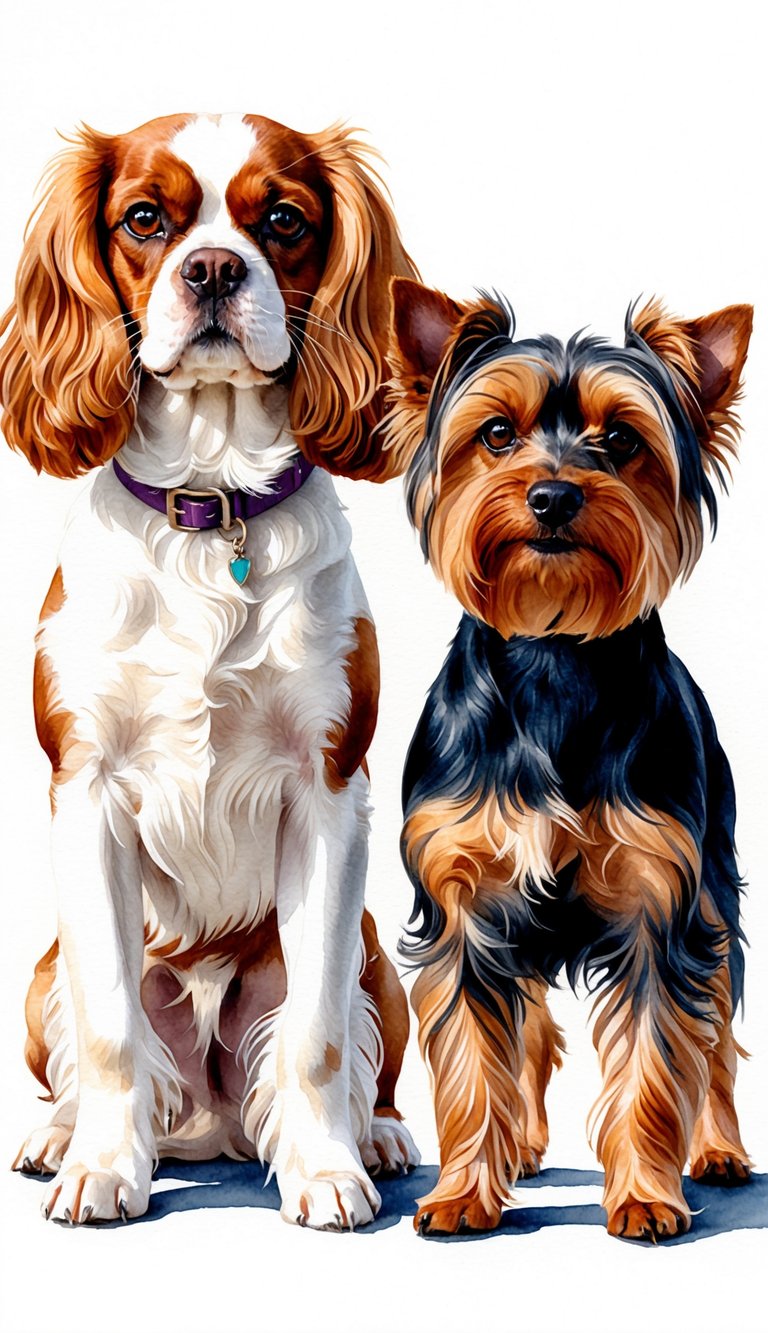
The Cavalier King Charles Spaniel and the Yorkshire Terrier can run into health problems as they get older. It helps to know what might come up so you can plan ahead and keep your dog happy.
Common Health Conditions
Cavalier King Charles Spaniels often face mitral valve disease, a heart problem that’s common in this breed. They’re also more likely to develop syringomyelia, which affects the brain and spine and can be painful.
Eye issues like cataracts or dry eye sometimes pop up, too. It’s not all doom and gloom, but you should keep an eye out.
Yorkshire Terriers have their own set of issues. Dental disease shows up a lot because their small jaws leave little room for their teeth.
Yorkies can also deal with collapsing trachea, which makes breathing tricky, and liver shunts, which can cause problems early on.
Unlike pugs or dachshunds, Cavaliers and Yorkies don’t usually have breathing or back problems unless there’s a mix in their background. Regular vet visits and catching things early make a big difference.
Heart Disease Concerns
Heart disease is a big worry for Cavalier King Charles Spaniels. Mitral valve disease is the main culprit, and it can show up as early as age five.
You might notice coughing, trouble breathing, or your dog getting tired after very little activity. If you catch it early and get the right meds, you can help your dog feel better for longer.
Yorkshire Terriers can get heart disease too, but it’s not as common as in Cavaliers. They sometimes develop heart murmurs later in life, but these rarely get serious until they’re older.
Regular heart check-ups are a good idea for both breeds, especially as they age.
Table: Heart Disease Comparison
| Breed | Main Heart Issue | At-Risk Age |
|---|---|---|
| Cavalier King Charles Spaniel | Mitral valve disease | 5 years & up |
| Yorkshire Terrier | Heart murmurs | 10 years & up |
Life Expectancy Comparison
Yorkshire Terriers usually outlive Cavaliers. Most Yorkies make it to 12 to 16 years.
If you keep up with dental care and keep them at a healthy weight, they can stay active well into their teens.
Cavalier King Charles Spaniels average about 9 to 14 years. Their shorter lifespan is mostly because of those heart problems.
Keeping your Cavalier fit and getting annual checkups will help them stick around longer. A dog’s diet, lifestyle, and regular vet care play a huge part in how long they stay healthy.
Trainability and Intelligence
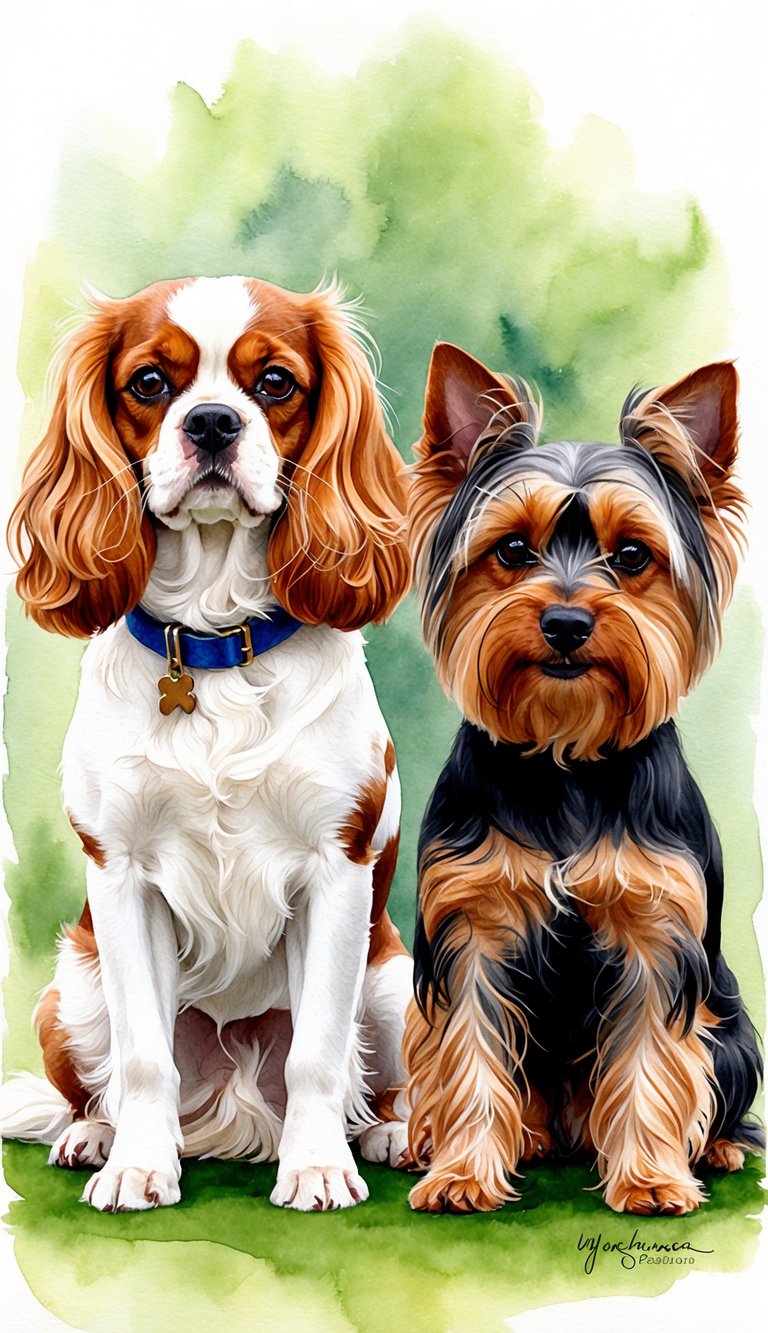
Cavalier King Charles Spaniels and Yorkshire Terriers are both smart, but their intelligence shows up differently. Their willingness to listen and their social quirks really matter when it comes to training.
Obedience and Learning Ability
Cavaliers want to make you happy and usually do well with reward-based training. They learn commands at a steady pace and don’t tend to be stubborn.
With some consistency, a Cavalier can master basics and even a few tricks. They’re fun to work with.
Yorkshire Terriers are clever, but they’re a bit more independent. Yorkies pick things up quickly, but sometimes ignore you if they’re bored or distracted.
Short, upbeat training sessions work best for Yorkies. If it gets repetitive, they’ll check out.
For context, breeds like Poodles and Border Collies are top performers in obedience and can handle complex tasks fast. Miniature Schnauzers are sharp too, but can show the same stubborn streak as Yorkies.
| Breed | Willingness to Obey | Ease of Training | Attention Span |
|---|---|---|---|
| Cavalier King Charles | High | Easy | Good |
| Yorkshire Terrier | Medium | Moderate | Short |
Socialization and Behavioral Traits
Cavalier King Charles Spaniels are friendly with just about everyone. Early socialization helps them stay gentle and relaxed around other dogs and people.
You won’t see much aggression or shyness with Cavaliers. They’re just easy-going.
Yorkshire Terriers are alert and brave, sometimes acting like they’re much bigger than they are. They might bark at strangers or sudden sounds.
Positive social experiences teach Yorkies when to chill out. Socialization is key to keeping bossy or nervous habits in check.
Both breeds do better when they meet different people and animals early on. Cavaliers usually slide into family life with no fuss. Yorkies might need a little more effort to help them stay calm and friendly.
Regular exposure to new situations helps prevent future anxiety or aggression.
Living Requirements
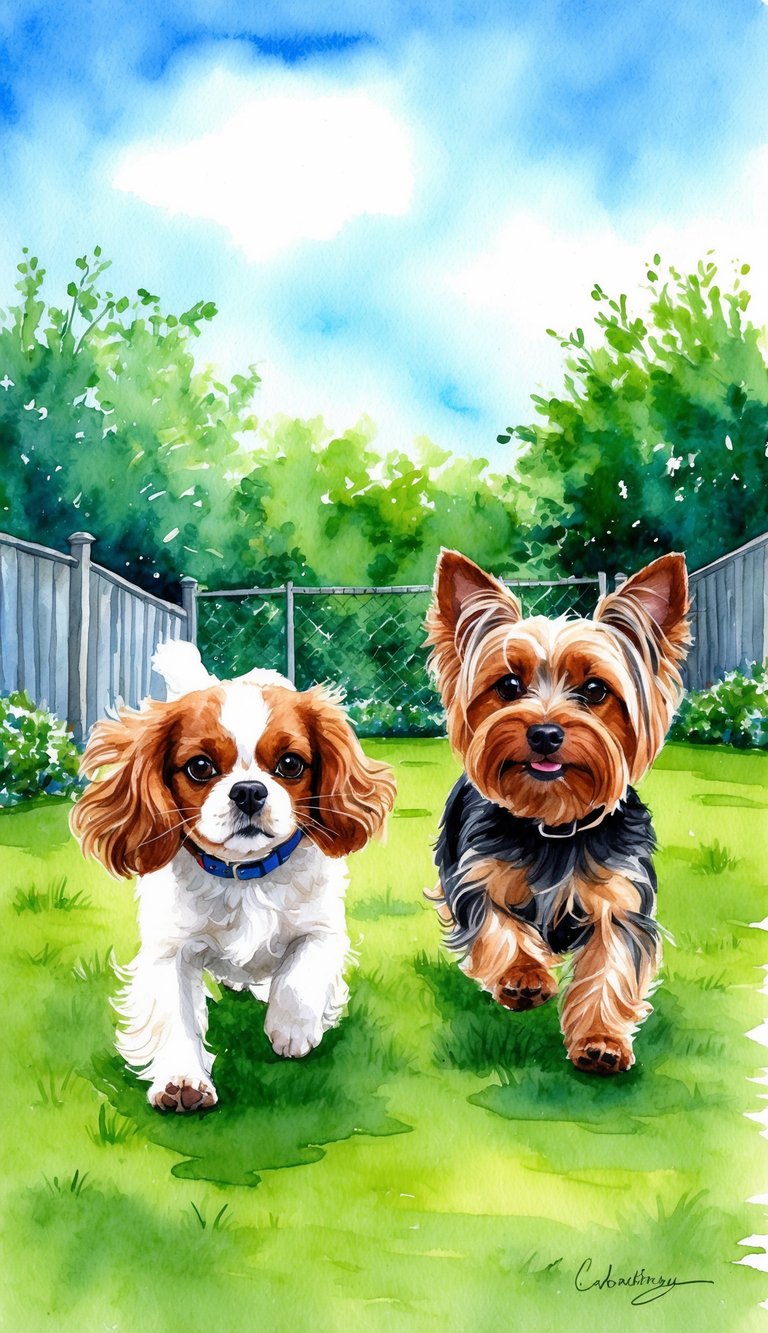
Cavalier King Charles Spaniels and Yorkshire Terriers are both popular small breeds that adapt well to different living situations. Still, they have their own quirks when it comes to space and comfort.
Apartment Suitability
Yorkshire Terriers fit right into apartment life. Their small size makes them easy to handle indoors.
They don’t need a big yard, but daily walks and playtime are a must. Keep them busy with toys and mental challenges.
Cavalier King Charles Spaniels also settle into apartments nicely. They’re quiet and polite around neighbors.
Cavaliers crave human company, so leaving them alone for long hours isn’t great. A few short walks and indoor play help them stay calm.
If your space is tight, both breeds can thrive as long as you meet their exercise and social needs. Honestly, it’s more about your routine and attention than the square footage.
Space and Environment Needs
Yorkshire Terriers don’t need a lot of room. A cozy corner with a soft bed works just fine.
Since they’re curious and alert, you’ll want to puppy-proof your place and keep it free from hazards. Yorkies are sensitive to cold, so make sure their area stays warm.
Cavalier King Charles Spaniels like cozy spots where they can see their family. They need a safe environment, especially since they’re gentle and can get anxious in loud homes.
Soft bedding, gentle lighting, and a spot near family members make Cavaliers happiest.
Both breeds make great family pets if you give them time, attention, and a safe place to relax. Even in a small apartment, a thoughtful setup helps your dog feel secure.
Compatibility With Other Pets
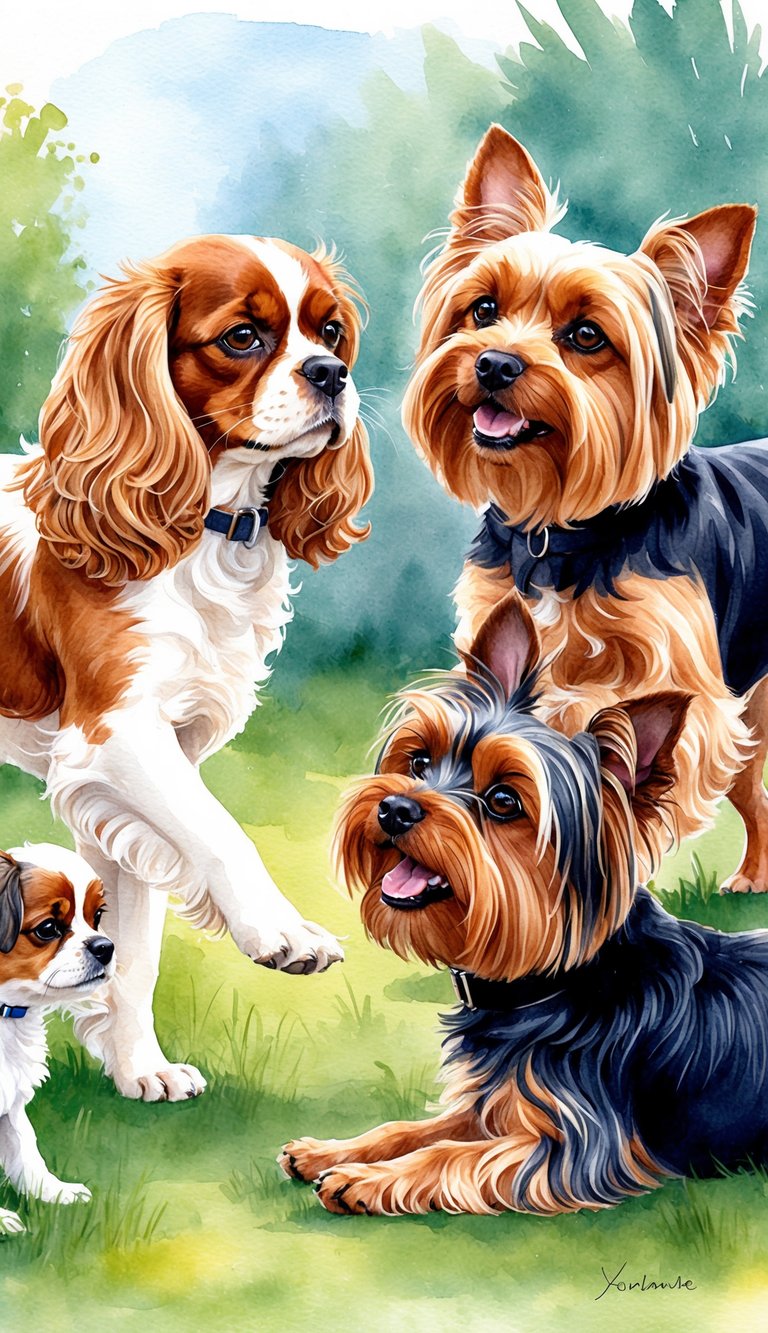
Cavalier King Charles Spaniels and Yorkshire Terriers can get along with other animals, but their personalities and upbringing play a big role. Training, socialization, and your household setup all matter.
Interaction With Dogs
Cavalier King Charles Spaniels are calm and usually enjoy other dogs’ company. They get along well with breeds like Pomeranians, French Bulldogs, and Boston Terriers.
Their friendly personality means they usually welcome new furry siblings without much fuss. Aggression or bossiness isn’t really their style.
Yorkshire Terriers can be more defensive, especially around bigger dogs. Sometimes they act fearless, barking at new dogs or guarding their space.
Early socialization helps Yorkies become friendlier playmates. If you introduce them to other dogs as puppies, they’re more likely to get along.
Here’s a quick comparison:
| Breed | Tolerance for New Dogs | Social Needs |
|---|---|---|
| Cavalier King Charles Spaniel | High | Loves company |
| Yorkshire Terrier | Moderate | Needs early socialization |
Living With Other Animals
Cavalier King Charles Spaniels usually fit right in with cats or small pets. They’re gentle and don’t tend to chase or bark at other animals.
Still, you should supervise when introducing them to fragile pets. Better safe than sorry.
Yorkshire Terriers sometimes have a stronger prey drive. They might chase cats, rabbits, or birds if you don’t teach them early.
With patience and careful introductions, Yorkies can adapt. It might take a little time, but you can create a peaceful home for both breeds and your other pets.
If you already have Pomeranians or similar small dogs, Cavaliers typically accept them easily. Yorkies may need a gradual introduction, especially if they see other small animals as rivals.
Cost and Ownership Considerations
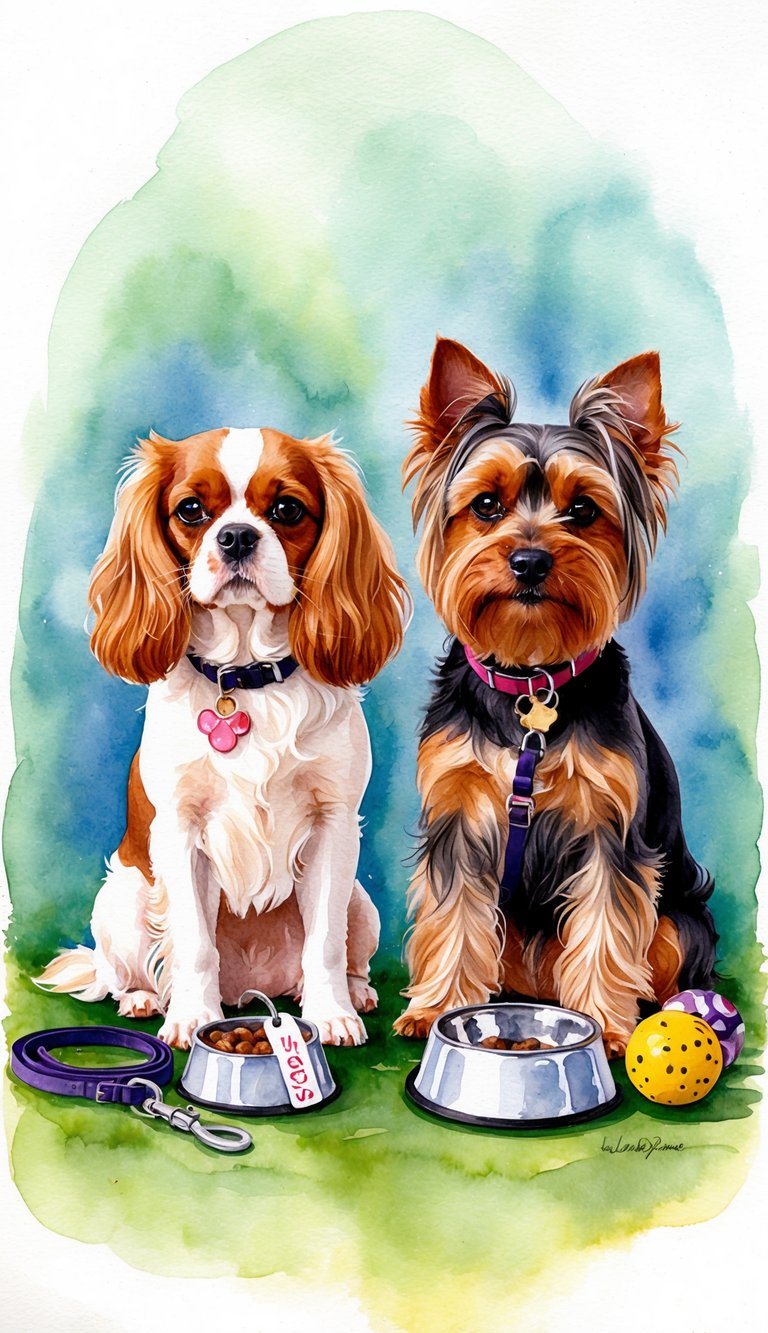
Cavalier King Charles Spaniels and Yorkshire Terriers come with specific costs and needs. You’ll need to think about the initial price, ongoing care, supplies, and the importance of picking a good breeder.
Initial Purchase Price
A Cavalier King Charles Spaniel from a reputable breeder usually costs between $1,500 and $3,500. Puppies with champion bloodlines can go for more.
Prices vary depending on your location and what’s included, like health checks or early shots.
A Yorkshire Terrier often costs between $1,000 and $3,000. If you’re looking for a show-quality pup or buying from a well-known breeder, expect to pay at the higher end.
You might find lower prices for older dogs or if you adopt. Extras like transport or registration papers can bump up the cost.
Always ask what’s included before you commit. It’s better to know up front than be surprised later.
Ongoing Expenses
Owning either breed means you’ll have regular expenses. Yearly costs for food, supplies, vet visits, and grooming can add up fast.
- Food: Cavaliers usually need a bit more food than Yorkies. Expect to spend about $350-$500 a year for Cavaliers, and around $300-$400 for Yorkies.
- Grooming: Both breeds need grooming. Professionals might charge $40-$60 per visit. Cavaliers need regular brushing and some trims, while Yorkies need frequent haircuts.
- Veterinary care: Plan for annual checkups, vaccines, parasite prevention, and dental care. This usually totals $300-$800 per year for both breeds.
You’ll also need to budget for toys, bedding, training, and maybe pet insurance. Depending on what you pick, yearly costs could reach $1,000-$2,000.
Availability and Choosing a Breeder
Both breeds are popular, but finding one isn’t always the same. Cavalier King Charles Spaniels may have longer waiting lists with top breeders, since some only have a few litters each year.
When you pick a breeder, look for someone who does health screenings on the parents. Pay extra attention to heart disease in Cavaliers and dental issues in Yorkies.
Responsible breeders let you visit, show you where the puppies and parents live, and actually answer your questions.
Don’t buy from pet stores or random online ads without checking them out. Ask for health certificates, vaccination records, and maybe references from other puppy buyers. The best breeders care about the dogs, not just making money.
Which Breed Is Right for You?

Both the Cavalier King Charles Spaniel and the Yorkshire Terrier make great companion dogs. Their needs and personalities suit different kinds of dog owners.
It’s honestly easier to decide by thinking about how each breed fits into day-to-day life and weighing the main pros and cons.
Lifestyle Compatibility
The Cavalier King Charles Spaniel usually fits best in calm homes with people around most of the day. This breed loves being with family and gets along well with children and other pets.
They enjoy playtime and short walks. Honestly, they’re just as happy relaxing indoors.
The Yorkshire Terrier is active and often bonds closely to one person. They’re small, but their personalities are bold.
You’ll need to spend time training Yorkies, since they bark and can be a bit stubborn. They do well in apartments if they get enough playtime.
If you want a dog to cuddle and relax with, the Cavalier feels like the obvious choice. If you’d rather have a lively, alert dog that’s small and easy to travel with, maybe a Yorkie is the better match.
Pros and Cons Overview
| Breed | Pros | Cons |
|---|---|---|
| Cavalier King Charles Spaniel | Very affectionate; gentle with kids; adapts to most homes | Needs frequent grooming; can have heart problems |
| Yorkshire Terrier | Good for small spaces; low-shedding coat; loyal | Prone to barking; can be fragile; grooming needed |
The Cavalier usually suits first-time dog owners or families who want a gentle, easygoing companion.
Yorkies work well for people who have more time for training and spend a lot of time at home.
Both breeds need regular grooming. They love being around people.
If you worry about allergies, you might find the Yorkie’s coat a bit easier to manage than the Cavalier’s.

